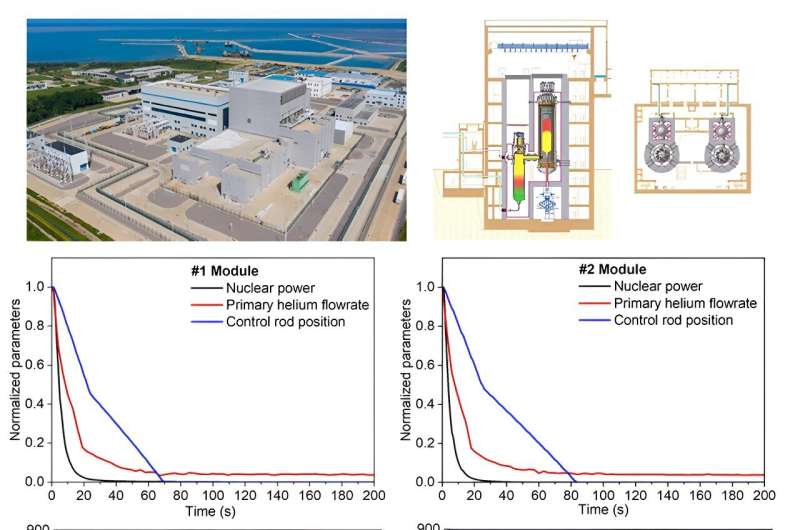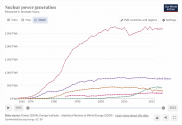You are using an out of date browser. It may not display this or other websites correctly.
You should upgrade or use an alternative browser.
You should upgrade or use an alternative browser.
Nuclear Energy
- Thread starter Strangelove
- Start date
PiSigma
"the engineer"
Lol. Nothing special about hastelloy, been using that for years in O&G. It's got a bit better corrosion resistance than stainless steel but really expensive. There are more exotic materials out there. Really desperate move to prohibit a normal material that's not even rare.
How much more expensive is it than steel? 50% more? 10X more?Lol. Nothing special about hastelloy, been using that for years in O&G. It's got a bit better corrosion resistance than stainless steel but really expensive. There are more exotic materials out there. Really desperate move to prohibit a normal material that's not even rare.
Nvm, seems to be in the 10-20X range. I wouldn't make the whole reactor out of it, but it certainly shouldn't be cost-prohibitive to make the molten salt plumbing out of it.
PiSigma
"the engineer"
Carbon steel which is what most piping and equipment is made of is base cost. Then stainless steel can be 2-4x more than carbon steel depending on grade. Hastelloy C is what I typically buy is 2x more than most stainless steel. But hastelloy C is used fairly sparsely, so the cost is not really a big issue. Most are constructed with carbon steel. Only for high corrosion resistance is hastelloy used.How much more expensive is it than steel? 50% more? 10X more?
On Sept 13, the Chinese government approved construction of four new nuclear power generators: the second phase of Zhangzhou in Fujian and the first phase of Lianjiang in Guangdong.
The Zhangzhou nuclear power station uses the Hualong-1 design. This second phase will add two generators at 1212 MW each.
The Lianjiang nuclear power station uses the CAP1000 design.
On April 20, the Chinese government approved construction of 6 new nuclear power generators: phase 2 of Jiangmen (Zhejiang), phase 2 of Haiyang (Shangdong), and No. 5 and No. 6 generators at Lufeng (Guangdong).
中国核电发布公告称,9 月 13 日,经国务院常务会议审议,决定对已经全面安全评估审查且纳入国家规划的福建漳州核电项目 3、4 号机组予以核准。
IT之家了解到,中国核电表示,公司控股的中核国电漳州能源有限公司,为核准项目的业主单位,负责项目投资、建设及运营管理。该项目为厂址规划容量内的二期扩建工程,机型为华龙一号,单台机组额定电功率为 1212MW。
中国核电在公告中指出,目前,项目现场正在稳妥有序推进开工前各项准备工作。公司目前无其他任何应披露而未披露的信息。
中国核电行业再次迎来利好。
9月13日召开的国务院常务会议指出,为提升能源保障能力和促进绿色发展,会议决定,核准已列入规划、条件成熟的福建漳州二期、广东廉江一期核电项目。强化全过程监管,确保安全万无一失。
福建漳州二期、广东廉江一期核电项目分别属于中核集团和国家电投集团,各有两台核电机组。第一财经记者从核电企业获悉,漳州二期使用的是“华龙一号”三代核电技术,廉江一期则使用CAP1000三代核电技术。
目前,每台第三代核电机组的总投资约为200亿元,这意味着上述4台核电机组总投资高达800亿元。
在技术上,“华龙一号”虽是中核集团和中广核联手打造的,但是两家公司在该机组的设计上略有不同。
相同之处是,两家公司的“华龙一号”都具备完善的严重事故预防与缓解措施、强化的外部事件防护能力和改进的应急响应能力等先进特征,经过充分分析试验和工程验证,充分保证了电厂安全性、经济性和先进性。
而CAP1000核电技术则是中国在多年以前从国外引进的AP1000技术及依托项目建设的过程中,全面消化吸收AP1000的设计、制造、建造技术而形成的。AP1000的依托项目,分别位于浙江三门一期项目和山东海阳一期项目,共涉及四台机组。
官方资料显示,截止到2019年1月,AP1000依托项目4台机组全部投入商业运行。据世界核电运营者协会(WANO)统计,在2019年全球403台参与评价的在运核电机组中,三门1号机组、海阳1号机组与其他62台机组并列获得满分100分。另据中国核能行业协会4月21日介绍,通过核电重大专项以及AP1000依托项目的实施,中国已经具备了国产化CAP1000核电自主设计、制造、建造及运维能力。
在上述两个核电项目获得核准之前,今年4月20日召开的国务院常务会议已经对三个核电新建机组项目予以核准,分别为三门核电二期,海阳核电二期,陆丰核电5、6号机组项目,每个项目分别有两台核电机组。其中,三门核电二期的业主为中核集团,海阳核电二期的业主为国家电投集团,陆丰核电5、6号机组项目的业主为中国广核集团。三个项目,分别位于浙江、山东和广东。
“今年以来,一共核准了8台核电机组,这是过去十几年来最多的一次。”一位核电人士在接受第一财经记者采访时说。
多位业内士均曾向第一财经记者表示,目前,多个沿海省份都希望建设更多的核电。究其原因,核电不仅投资大,可快速拉动经济,而且具有“清洁、低碳、能量密度高”的属性,同时不受季节和气候等因素影响,除短暂的换料大修外,能以额定功率长期稳定运行。
今年以来,广东、广西、福建、海南、江苏、山东、辽宁等地纷纷将核电写入当地经济发展规划,并列为2022年工作重点之一。去年则有广东、福建、海南和辽宁4省将核电写入当地政府工作报告。
值得关注的是,8月29日,工信部、财政部、商务部等五部门联合印发的《加快电力装备绿色低碳创新发展行动计划》提出,通过5-8年时间,电力装备供给结构显著改善,核电装备满足7000万千瓦装机需求,进一步加快三代核电的批量化,加速四代核电装备研发应用。
中国核学会理事长王寿君不久前介绍,预计在2022年至2025年间,中国将进一步加快扩大装机规模,保持每年6-8台核电机组的核准开工节奏,2025年核电运行装机容量达7000万千瓦左右;到2035年,中国核电在总发电量中的占比将达到10%,相比2021年翻倍。
The Zhangzhou nuclear power station uses the Hualong-1 design. This second phase will add two generators at 1212 MW each.
The Lianjiang nuclear power station uses the CAP1000 design.
On April 20, the Chinese government approved construction of 6 new nuclear power generators: phase 2 of Jiangmen (Zhejiang), phase 2 of Haiyang (Shangdong), and No. 5 and No. 6 generators at Lufeng (Guangdong).
中国核电发布公告称,9 月 13 日,经国务院常务会议审议,决定对已经全面安全评估审查且纳入国家规划的福建漳州核电项目 3、4 号机组予以核准。
IT之家了解到,中国核电表示,公司控股的中核国电漳州能源有限公司,为核准项目的业主单位,负责项目投资、建设及运营管理。该项目为厂址规划容量内的二期扩建工程,机型为华龙一号,单台机组额定电功率为 1212MW。
中国核电在公告中指出,目前,项目现场正在稳妥有序推进开工前各项准备工作。公司目前无其他任何应披露而未披露的信息。
中国核电行业再次迎来利好。
9月13日召开的国务院常务会议指出,为提升能源保障能力和促进绿色发展,会议决定,核准已列入规划、条件成熟的福建漳州二期、广东廉江一期核电项目。强化全过程监管,确保安全万无一失。
福建漳州二期、广东廉江一期核电项目分别属于中核集团和国家电投集团,各有两台核电机组。第一财经记者从核电企业获悉,漳州二期使用的是“华龙一号”三代核电技术,廉江一期则使用CAP1000三代核电技术。
目前,每台第三代核电机组的总投资约为200亿元,这意味着上述4台核电机组总投资高达800亿元。
在技术上,“华龙一号”虽是中核集团和中广核联手打造的,但是两家公司在该机组的设计上略有不同。
相同之处是,两家公司的“华龙一号”都具备完善的严重事故预防与缓解措施、强化的外部事件防护能力和改进的应急响应能力等先进特征,经过充分分析试验和工程验证,充分保证了电厂安全性、经济性和先进性。
而CAP1000核电技术则是中国在多年以前从国外引进的AP1000技术及依托项目建设的过程中,全面消化吸收AP1000的设计、制造、建造技术而形成的。AP1000的依托项目,分别位于浙江三门一期项目和山东海阳一期项目,共涉及四台机组。
官方资料显示,截止到2019年1月,AP1000依托项目4台机组全部投入商业运行。据世界核电运营者协会(WANO)统计,在2019年全球403台参与评价的在运核电机组中,三门1号机组、海阳1号机组与其他62台机组并列获得满分100分。另据中国核能行业协会4月21日介绍,通过核电重大专项以及AP1000依托项目的实施,中国已经具备了国产化CAP1000核电自主设计、制造、建造及运维能力。
在上述两个核电项目获得核准之前,今年4月20日召开的国务院常务会议已经对三个核电新建机组项目予以核准,分别为三门核电二期,海阳核电二期,陆丰核电5、6号机组项目,每个项目分别有两台核电机组。其中,三门核电二期的业主为中核集团,海阳核电二期的业主为国家电投集团,陆丰核电5、6号机组项目的业主为中国广核集团。三个项目,分别位于浙江、山东和广东。
“今年以来,一共核准了8台核电机组,这是过去十几年来最多的一次。”一位核电人士在接受第一财经记者采访时说。
多位业内士均曾向第一财经记者表示,目前,多个沿海省份都希望建设更多的核电。究其原因,核电不仅投资大,可快速拉动经济,而且具有“清洁、低碳、能量密度高”的属性,同时不受季节和气候等因素影响,除短暂的换料大修外,能以额定功率长期稳定运行。
今年以来,广东、广西、福建、海南、江苏、山东、辽宁等地纷纷将核电写入当地经济发展规划,并列为2022年工作重点之一。去年则有广东、福建、海南和辽宁4省将核电写入当地政府工作报告。
值得关注的是,8月29日,工信部、财政部、商务部等五部门联合印发的《加快电力装备绿色低碳创新发展行动计划》提出,通过5-8年时间,电力装备供给结构显著改善,核电装备满足7000万千瓦装机需求,进一步加快三代核电的批量化,加速四代核电装备研发应用。
中国核学会理事长王寿君不久前介绍,预计在2022年至2025年间,中国将进一步加快扩大装机规模,保持每年6-8台核电机组的核准开工节奏,2025年核电运行装机容量达7000万千瓦左右;到2035年,中国核电在总发电量中的占比将达到10%,相比2021年翻倍。
Any news on China's prototype thorium reactor? Also, the plan was to build a commercial 300 megawatt plant by 2030. Even mass produced conventional PWR plants usually tend to take 4-5 years in China. The very first full powered 300 megawatt thorium reactor should take a lot longer so they should have plans to build the 300 megawatt plant soon if they want to meet the 2030 deadline.
Last edited:
broadsword
Brigadier
Cheers!
JULY 24, 2024First meltdown-proof nuclear reactor passes loss of cooling test in China
by Bob Yirka , Tech Xplore
A team of engineers from Tsinghua University, working at China's high-temperature reactor with a pebble-bed module (HTR-PM), claims that the reactor has passed a critical cooling test. In their study, in Joule, the group turned off external power to the reactor to test its cooling abilities over two days.
One of the major drawbacks of using to generate electricity is the fear of a meltdown, possibly exposing populations to radiation. Scientists have been working to develop designs for nuclear reactors that do not melt down if their coolant supply is interrupted. In this new study, the team in China tested the HTR-PM design, in which the used in reactions are less dense than those currently used.
They employ more graphite and less uranium, and the uranium is encased. The design results in slower reactions and the ability to sustain higher temperatures for longer periods of time. It also disperses heat over a larger area, which means can be done passively, using either convection, conduction or both. That means that no source is needed for cooling.
The design would have prevented the meltdown that occurred at the Fukushima Daiichi plant in Japan in 2011. In that accident, a tsunami caused a that made it impossible to pump the water used to keep the reactors cool, which allowed them to overheat.
The new nuclear plant in China has been under construction and testing since 2016—it has two reactors, each capable of generating 105 MW of power. It began operations last year. The research team sought to prove that the plant is incapable of melting down by revving both reactors up to full power and then turning off all external power—this immediately stopped water flowing to and from the turbines that are used to generate power.
The researchers then monitored the plant in case of a meltdown, which did not occur; instead, stable temperatures were reached within 36 hours.
Time for an update about China's uranium factory. The Emeishan Uranium factory expands again in 2024, potentially due to heavy demand of naval reactor.
Now totaling at 16.8 - 19.8 million SWU/year after expansion. Even 1% of capacity is worth 740kg Weapon grade HEU.
View attachment 135749
Bidding source:
This is great stuff from @Kalec
I don't know how much we can really credit to military here since nuclear submarine usage is likely minimal compared to what's needed on the power plant. But 16.8m SWU to 19.8m SWU is huge.
using this
America has just Urenco with 4.6m SWU capacity. And relies extensively on Russian enriched uranium.
Using table from here from back in 2020
Russia had 27m in SWU capacity and China had just 6.3m. Looks like in the past 4 years, China has tripled. Quite a big deal here.
The US used to be self-sufficient in terms of enriched uranium but they used the gas diffusion process of enrichment. This is several orders of magnitude less efficient than modern gas centrifuges. After the Soviet collapse, the US started buying enriched uranium from Russia. At first this was done to destroy the Soviet weapons stockpile by downblending the uranium in nuclear weapons and burning it in nuclear reactors as fuel. But eventually fuel purchases expanded, the fuel price crashed down, the US gas diffusion plants were closed down because they weren't profitable anymore. Not against much cheaper Russian gas centrifuge uranium. The US did an international competition to build uranium centrifuge enrichment facilities in the US. Orano (FR), Urenco (NL/UK/DE), and TVEL (RU) competed in this. Only Urenco was funded to build that facility. The US also had its own gas centrifuge technology in development, but it was pretty much a failure, and was shut down only to be resurrected recently.
Urenco's centrifuges are based on technology developed in Europe after Gernot Zippe left the Soviet Union and spread out to the West that the Soviets had working gas centrifuges.
Orano's centrifuges are licensed versions of the ones used by Urenco.
Urenco and Orano have programs to increase their production by using what limited space they have available in their facilities. But growth in production with this will be marginal. They need to build new facilities to replace Russian capacity but these have not even been started yet.
China is quickly ramping up its nuclear power plant park so they need more enriched uranium. China already surpassed France and is #2 in nuclear power generation. Eventually they will surpass the current #1 the US as well.

Urenco's centrifuges are based on technology developed in Europe after Gernot Zippe left the Soviet Union and spread out to the West that the Soviets had working gas centrifuges.
Orano's centrifuges are licensed versions of the ones used by Urenco.
Urenco and Orano have programs to increase their production by using what limited space they have available in their facilities. But growth in production with this will be marginal. They need to build new facilities to replace Russian capacity but these have not even been started yet.
China is quickly ramping up its nuclear power plant park so they need more enriched uranium. China already surpassed France and is #2 in nuclear power generation. Eventually they will surpass the current #1 the US as well.

Last edited:
